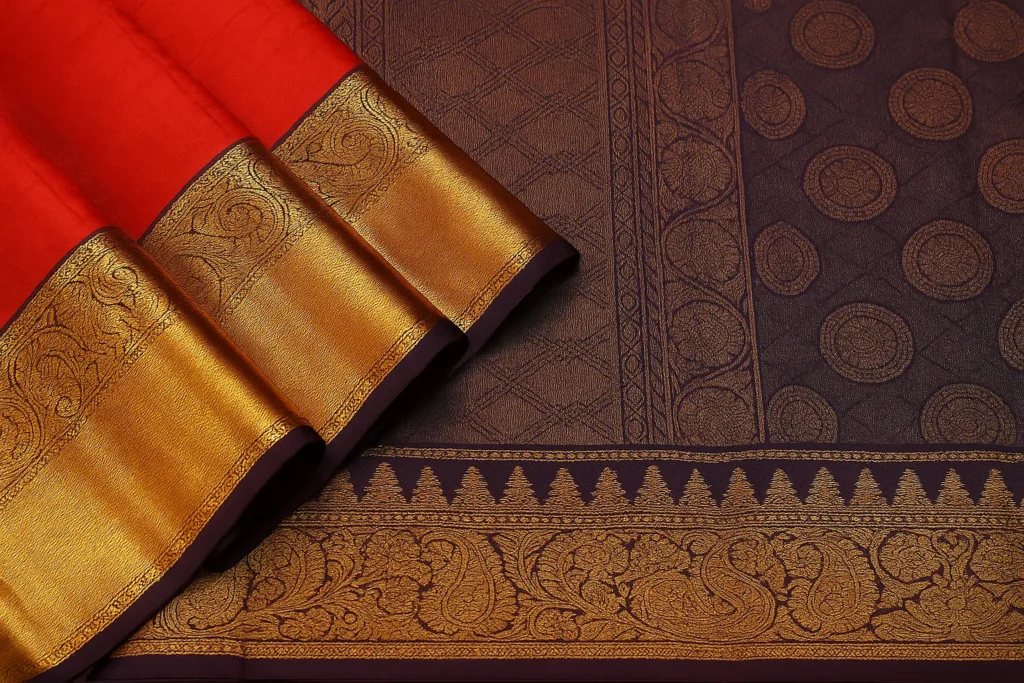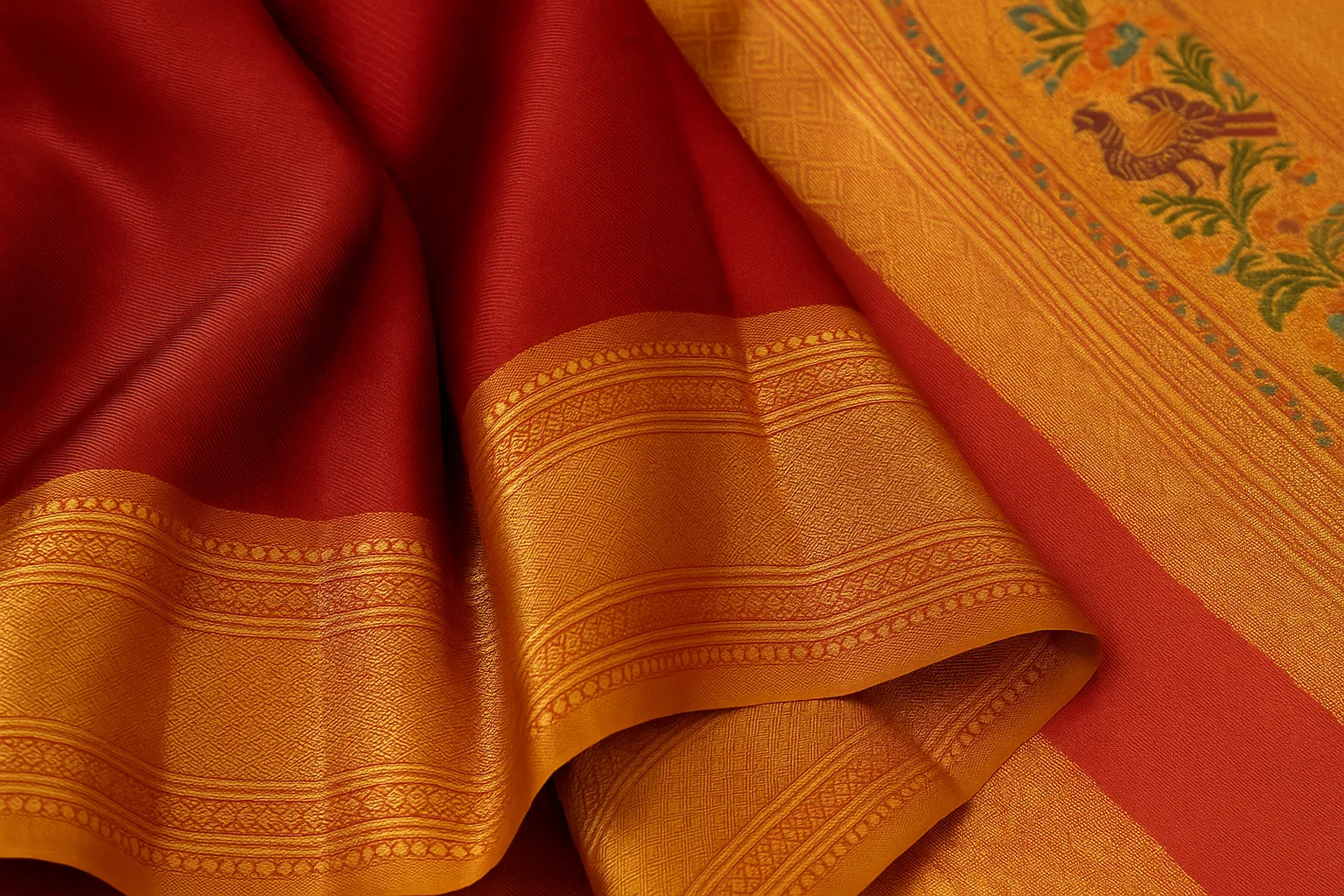Kanjivaram silk sarees are more than just pieces of fabric—they are heirlooms, symbols of tradition, and treasured works of art. But in a market flooded with imitations, figuring out if your saree is truly an original Kanjivaram can feel overwhelming.
This guide walks you through the practical ways to identify a pure Kanjivaram silk saree, so you can buy with confidence and cherish what you own. Whether you’re shopping for a wedding or simply investing in one of India’s most iconic handlooms, here’s what to look out for.
The Origins of a Kanjivaram Saree
Let’s begin with what makes Kanjivaram sarees special in the first place. Kanjivaram, or Kanchipuram sarees, come from the temple town of Kanchipuram in Tamil Nadu. These sarees are handwoven using mulberry silk and zari (real gold or silver thread), known for their rich textures and bold color contrasts. What sets them apart is the intricate craftsmanship, often passed down through generations of weavers. So when you’re buying a Kanjivaram saree, you’re not just buying fabric. You’re buying history, skill, and authenticity.
How to Identify a Pure Kanjivaram Silk Saree

Check the Silk Quality
The first clue lies in the feel and appearance of the silk. A real Kanjivaram saree is made from high-quality mulberry silk, which is soft but heavy. When you touch it, it should feel thick and luxurious. If it feels flimsy or too light, there’s a high chance it’s a blend or imitation. Pure silk also has a natural shine that isn’t too glossy or artificial. Tilt it under light and see how it reflects—it should glow with elegance, not glare like synthetic material.
Look for the Signature Zari Work
The zari is where true craftsmanship shines. Original Kanjivaram sarees use zari made from pure silver thread coated with gold. This zari is woven into borders, pallu, and motifs, giving the saree its signature grandeur. You can test the zari by gently scratching it with a pin or your nail. If there’s a red thread underneath, it’s likely fake. Real zari threads are white or off-white due to the silver core beneath the gold coating. This is one of the most reliable signs when learning how to identify a pure kanjivaram silk saree.
Observe the Borders and Pallu
One unique feature is how the border and body are woven separately. Kanjivaram sarees are known for a technique where the body and border are woven independently and then joined together with a zigzag pattern called “Korvai”. If you look closely where the body meets the border, you should be able to spot this traditional join. Imitation sarees often skip this detail and print or stitch borders in a way that lacks that handcrafted look. So when you’re examining a saree, give extra attention to where the pallu and border meet the main body of the fabric.
Test with the Burn Method (if possible)
This old-school method still works, but use it with caution. Pull out a tiny fiber from the saree and burn it. If it smells like burnt hair and leaves behind a black ash, it’s real silk. Fake silk or blends will smell more like burnt plastic and leave behind a hard bead-like residue. Of course, don’t do this with a full saree in-store—but it’s useful if you already own one and want to verify its authenticity.
Check for a Silk Mark Certification
When in doubt, trust the official stamp. The Government of India provides a “Silk Mark” certification through the Silk Mark Organization of India. If you’re buying from a reputed store or brand, ask whether the saree has this certification. It’s not the only sign of authenticity, but it’s a strong backup when paired with the other tips in this list. Remember, a real kanjivaram saree with a Silk Mark is more than a beautiful garment—it’s a promise of quality.
Feel the Weight of the Saree
Another indicator lies in the heaviness of the saree. Pure Kanjivaram sarees are weighty because of the density of silk and zari used. When you drape it over your arm, it should feel substantial. Some can weigh up to 2 kilograms. Lighter sarees that claim to be Kanjivaram are often synthetic or mixed with cheaper threads. This is one of those little things that people overlook—but once you’ve felt an original kanjivaram saree, you’ll know the difference.
Examine the Weaving Details and Motifs
The motifs in Kanjivaram sarees tell a story. Traditional motifs include peacocks, elephants, mangoes, temple borders, and checks. These aren’t just pretty designs—they reflect South Indian heritage and are woven with incredible precision. Run your fingers over the motifs. In a genuine saree, you’ll feel the texture because it’s handwoven. Printed or machine-made sarees will feel flat and lifeless in comparison.
Beware of Too-Good-To-Be-True Prices
Authenticity comes at a cost. A pure Kanjivaram silk saree takes days, sometimes weeks, to weave. Add to that the cost of silk and zari, and you’re looking at a premium product. If someone offers you a Kanjivaram saree at a heavily discounted rate, be cautious. While there are simpler, budget-friendly versions, genuine ones will always come at a justifiable price. Before buying, always research the brand and check their reviews. You can always turn to NutBolt India when you’re curious to learn more about the what, why, and how behind traditional Indian crafts and culture.
Trust Reputed Sellers and Brands
Finally, where you buy your saree matters as much as the saree itself. Look for trusted handloom stores or certified online sellers that specialize in traditional weaves. Some weavers even register their sarees with unique codes for traceability. Buying directly from Kanchipuram weavers or through reliable vendors reduces the chances of being duped. Ask questions. A good seller will be happy to explain the origin, weaving technique, and materials used in your saree.
Final Thoughts
Knowing how to identify a pure kanjivaram silk saree is about observing, feeling, and asking the right questions. From silk texture to zari quality and from weaving technique to certification—every detail tells you something about its authenticity. Next time you shop for one, use this guide as your checklist. With the right knowledge, you can make a confident purchase and enjoy the timeless beauty of a real kanjivaram saree.













